News
Interview with Jeb Brugmann
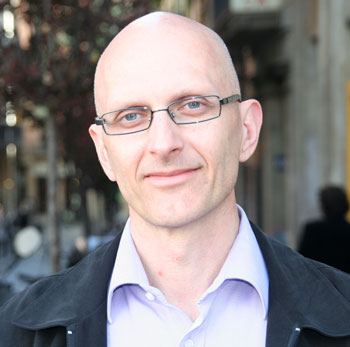 Image credit: Anna Bolud
Image credit: Anna Bolud
In "Welcome to the Urban Revolution: How Cities are Changing the World," you point out that half of the world's population now lives in cities, which means that half the world has become a city. While national governments and U.N. organizations seemingly dominate, this new global city has changed the actual "concrete order" of the international system. This global city is one of the more tangible forms of globalization. Why the global city? How are cities forming a global system?
This is a self-organizing process. My book is very much in the tradition of Jane Jacobs. What Jane Jacobs said was happening within a neighborhood is also actually happening at the global level. My argument is cities are primarily an economic space in our time of globalization, and we have not yet learned how to optimize those spaces.
There are three things getting in the way. One is we don't understand natural economies of cities. Why does everyone want to be in an urban location, from the corporation to the poorest person in the world? Secondly, how do you get people who seek urban locations for their own economic purposes to align around a common strategy for that space so that multiple individual urban strategies can be served through the way the city has developed, rather than working against each other? Otherwise, you have all kinds of conflict. People in these communities are trying to design and build the city to serve a strategy that competes with the strategies of others. The third problem is the industry we turn to to build cities has a very risk-managing, standardized, mass production-type approach; it doesn't allow us to optimize and customize solutions for different city-building communities, or for new strategies, like sustainability.
The global city system grows because people secure locations in individual cities that allow them to develop their business, become a hub of criminal activity, or form a social community of some kind, say an immigrant neighborhood. Their community creates locations in a network of other cities around the world that provide them with distinct urban economic advantages. The city in which a company or immigrant community operates is actually the network of locations they form in cities around the world. The global city system is the total outcome of this self-organizing process of everyone trying to get anchors in a network of cities in order to achieve a larger strategy.
You say that in China increasingly widespread social protest is directly related to design efficiencies and the mismanagement of urbanization. Both developing and developed countries are experiencing problems associated with rapid urban growth, with two billion more expected to join the ranks of city dwellers by 2030. What can cities do to better manage rapid urbanization? Can this rapid urban migration even be managed?
This competition for urban space by all of these diverse groups that want to secure the natural economies of urban location is inherently chaotic, right? No one's coordinating and orchestrating this. You can't model it. In order to manage it, what one needs to do is become effective in supporting the self-organizing process of what I called city-building communities. One needs to understand the strategies of different groups struggling to secure urban locations and figure out how you can enable the design of city spaces in a way that a group of interests or communities can co-locate in the location and use it together. Through their co-location they can jointly create economic advantage together.
We see this in districts all over the world. You see different industries clustering together along with different social or demographic groups that service and are employed in those industries. This is the process of urbanism, a self-organizing of communities, often times through conflict. This can actually become a managed process. By understanding the strategic interests of the groups trying to secure urban locations, you can use urban design as the way to try to co-locate them together and align their different economic strategies.
My whole book is about what I call urban strategy. The fundamentals of urban strategy involve using rich design processes to align the competing economic interests of different communities trying to secure urban locations.
You point to Dharavi, India as a model "city system." What is special about Dharavi? How is this city system model superior to the others you mention in your book -- ad hoc city building, city models and master-planned cities?
Dharavi is a specific user community that has particular economic strategy, which is about using cash-based economic activity to generate enough wealth to incrementally invest in property and business development. It's a slum community that's based on a cash economy. What they've done over a few generations of trial and error in Dharavi is to figure out a highly cost-effective and productive way to build urban space in order to compete as an informal, so called slum-based, manufacturing community in the global economy. It's different than ad hoc city building. It started as ad hoc -- it started as a trial and error process and it was messy, which is why it was called a slum, right? But what they've done through ad hoc trial and error over a few decades is figure out a form of urban development that optimizes space for the user community.
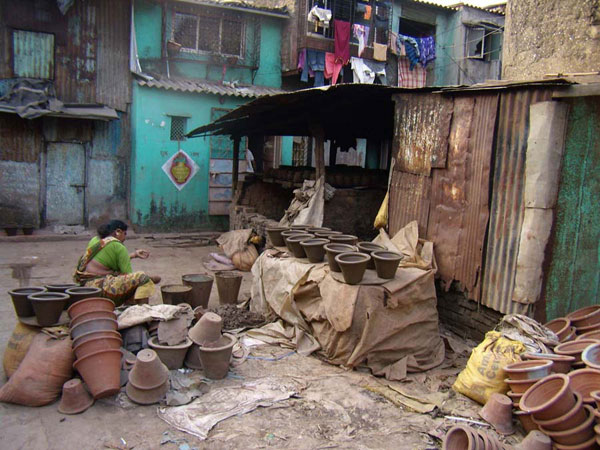 The ‘kumbarwada’ residential pottery production district of Dharavi, Mumbai, one of numerous Dharavi enterprise districts with distinct urban design characteristics developed by its user community. / Image credit: Gabriel Britto
The ‘kumbarwada’ residential pottery production district of Dharavi, Mumbai, one of numerous Dharavi enterprise districts with distinct urban design characteristics developed by its user community. / Image credit: Gabriel Britto
That's different than what I've called city model. What I call a city model is basically a business model tied to a very standardized form of building product, like a condo tower. A condo is a business model for how you divide up space and sell it on the market. The model involves common ownership of property, but you sell the unit. You need building types to be relatively standardized to deliver that model. So, a city model is not customized for anyone. It is a standardized, risk-tested, value-engineered model for the developer, offering a very basic standard utility to a user.
Master plan approaches to cities can be a route to supporting a real urbanism as much as ad hoc can be. However, typically, the master plan model is a way to take a big piece of property and prepare it for the implantation of a bunch of city models. The master plan district is now a bunch of condo towers, office buildings, and shopping malls. Maybe, there's a designed cultural facility so that you have unique identity there, too. It's very different from this self-organizing process of a user community customizing a way of urban design and city-building to their specific needs.
In a successful city system, communities can "creatively use density to enable proximity and concentration." What does this mean? How is this done in practice?
I think density is wrongly understood. Its planning community interpretation is the number of people located per acre or per unit of land. As an economic concept, which I think density really is, it's a way of optimizing the use of a particular piece of urban space by increasing the number of compatible activities in a unit of space. What does that mean? Number of users, yes, that's the quantitative dimension of it, but the qualitative aspect of density is co-location of uses within a space so that 24/7 value is created. By mixing the right uses together, they offer what's called positive externalities; they mutually support each other's ambitions. If you're going to create infrastructure, let's make sure that infrastructure is used as much as possible, 24/7 around the clock, so that you get a better return on your investment.
I come back to density as being a fundamental economic concept. There are many different kinds of density. You can design spaces for different user communities that involve more people per area or more co-location of different kinds of uses that are mutually compatible with one another to increase the overall wealth created or activity taking place. To me, that's density, and depending on the user community and the specific location, there are many ways to build that density.
Dharavi has two to three-story building density and Hong Kong is a 40 to 50-story density. They're very different densities, but the basic economic value of this kind of density creates in terms of a physical design is common. Also, Dharavi's two or three-story density has probably more people per square kilometer than Hong Kong's density at 40, 50-stories. Figure that out, but it has to do with dividing the room inside a building into a much smaller units.
People get really dogmatic that density is about high rise buildings. We only see density as high-rise buildings because all the industry offers to us when we ask for density is high-rise buildings. There are many forms of density.
You talk a lot about the role people play in shaping urban environments and how communities are, in effect, creating new urban ecosystems. For instance, University of Arizona research in Phoenix found that the diversity of plants is strongly related to family income. "Higher family income, higher plant diversity, lower family income, lower plant diversity." Are these new urban environments created within neighborhoods and cities actually real ecosystems given they require external inputs -- imported oil, water, fertilizer to survive? Will they ever be sustainable?
The only way they become real ecosystems is if they become places of primary energy and nutrient production. The eco-district or eco-city of the future could be a place that internalizes its energy and nutrient production. The second dimension would be the global city system or cityscape, and actually providing inputs from within urbanized land areas. This is a big challenge in terms of planning, design, and technology, but I think it's possible to create real urban ecosystems.
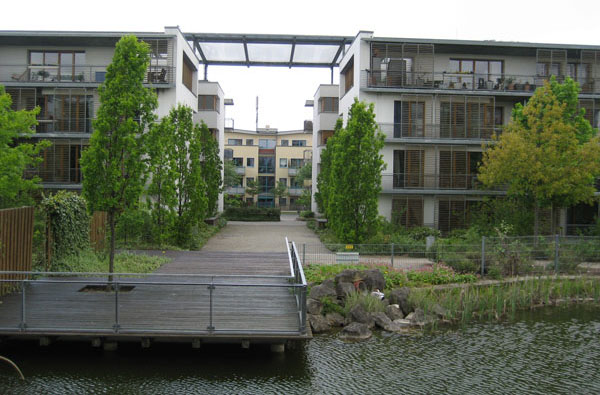 The Kronsberg eco-district of Hannover, Germany provides a view of the ecological potential of custom-designed city spaces. This 7,000-resident, public-private development for middle to middle-low income residents achieves an 80 percent reduction in typical household energy consumption and produces nearly zero storm water run-off. / Image credit: Jeb Brugmann
The Kronsberg eco-district of Hannover, Germany provides a view of the ecological potential of custom-designed city spaces. This 7,000-resident, public-private development for middle to middle-low income residents achieves an 80 percent reduction in typical household energy consumption and produces nearly zero storm water run-off. / Image credit: Jeb Brugmann
Each city's "energy metabolism," its rate of energy consumption, depends on how compact or extended it is, you argue. What are some best practice policies, regulations, technologies to slow a city's metabolism -- to reduce its energy use and greenhouse gas emissions?
The principle of economies of density needs to be applied to energy and transportation systems in order to optimize the efficiencies of those systems. The economies of density is a basic economic concept that needs to be applied to water, business, energy, mobility, and wealth-production. What you learn from cities that are starting to reach towards 20-30 percent reductions in greenhouse gas (GHG) emissions and have targets of 80 percent is the need to create a highly-dense system of energy and transportation.The first thing they do is reduce transportation demand by co-locating peoples' day-to-day life activities. You create options other than the automobile or even public transport for getting to work. They can ride a bike or walk.
Secondly, they invest in infrastructure. Curitiba, Brazil is a case of this. They invest in infrastructure and then create a system that optimizes the use of that infrastructure. In Curitiba, you can get a bus within 500 meters of anywhere in the city. There's a bus less than every 60 seconds. By creating many different kinds of services and bus routes on that infrastructure, they optimize the capital investments that they put into that --a very basic economic idea. This optimization provides people what you could call a portfolio choice of transportation solutions, the same can apply to energy solutions. The user can adjust their portfolio of transportation or energy solutions depending on their evolving needs. It's that ability to customize the energy or the transportation portfolio day to day, month to month, year to year as they meet new economic challenges that allows them as people in the city to optimize their resource use of the city and reduce their cost.
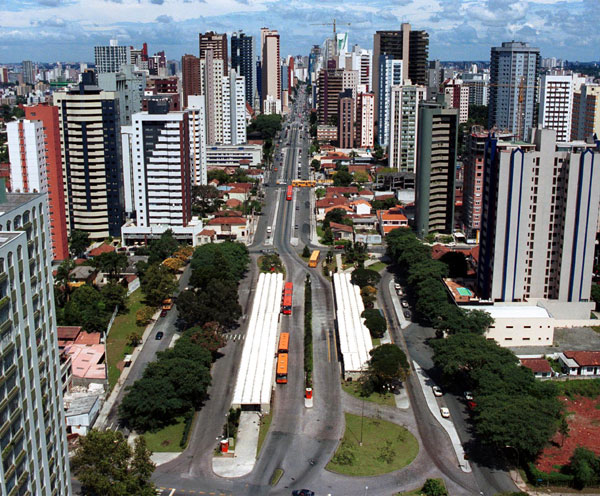 The success of Curitiba’s customized bus rapid transit system is based in economies of density—not just high-rise residential populations abutting the transit corridors, but further ‘sweating’ of the system’s capital investment by running ten specialized types of bus service, each using customized bus designs, on the same network. / Municipality of Curitiba.
The success of Curitiba’s customized bus rapid transit system is based in economies of density—not just high-rise residential populations abutting the transit corridors, but further ‘sweating’ of the system’s capital investment by running ten specialized types of bus service, each using customized bus designs, on the same network. / Municipality of Curitiba.
Again, I come back to seeing people through from an economic lens. Ultimately, they are enabled by information. If I don't know what the portfolio choices are available to me at this hour of the day and it's not at my fingertips, I will revert to a very fixed way of thinking about my transportation options, which is get in my car because I don't know what other options there are. Providing information loops to people so that they can say, "Well, today I can make that trip by doing this and this and this differently and that would reduce my cost and ultimately reduce my greenhouse gas emissions." That's the final step in creating what I call an optimized energy or transportation system. Likewise with my household, how do I get information on how I could invest in my insulation budget this year versus consuming natural gas, and sort of manage a portfolio of energy choices year to year?
Both Chicago and Curitiba, Brazil are cited as models of the way forward. You call them strategic cities. How have they been strategic? How have they leveraged existing community networks? At a very practical level, what can other cities do now to become more strategic?
If the growth of our cities is so chaotic, if there is competition to secure space for competing economic purposes, how do we somehow align that competition and make some coherent outcome? You'll find in Chicago, Curitiba, Brazil, and Barcelona what they did is create institutions whose purpose was to develop and innovate around customized solutions for problems that weren't being addressed by government or by the mass-market city-building industry.
Chicago has a unique set of problems with maintaining a large stock of low-income rental housing for people. They needed unique institutions that understood how to solve problems around maintaining affordability and renewing existing housing stock. They experimented in neighborhoods and scaled those things up across the city.
What I call strategic institutions are critical and they typically are located outside of government and industry. They're a common space where industry, community, and government work together to test innovation out in the marketplace. It's that institutional fabric that gives them the ability to generate new solutions to problems facing the city as it goes through boom, bust cycles. In Chicago, it's the $1/2 billion Community Investment Corporation (CIC) fund that actually secures old rental properties in neighborhoods, gets them in the hands of owners, helps finance their renewal, and gets them back on the market as affordable housing so they don't get gentrified. NeighborSpace and CIC are examples of two institutions that are sort of quasi-public. They are in the market, they're private sector models, but they generated solutions that neither industry or government would be able to do, given who they are.
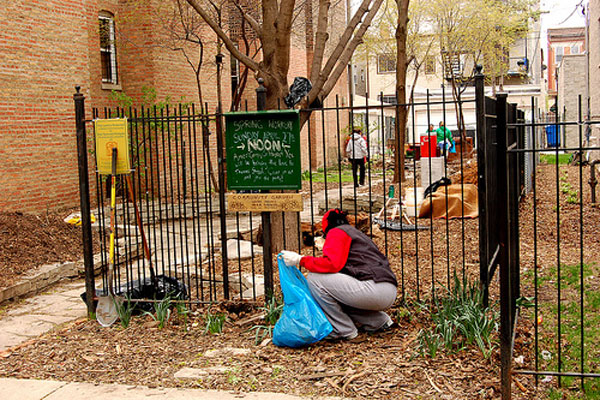 NeighborSpace is an example of a ‘strategic institution’: an organization designed to align competing interests and customize local solutions for a key development objective. In this case, NeighborSpace is a non-profit organization established by the City of Chicago, Chicago Park District, and Forest Preserve District of Cook County to align the interests of neighbors, landowners, and public agencies to establish more community-managed green spaces in the city’s abandoned lots or underused public lands. / Image credit: NeighborSpace, Chicago
NeighborSpace is an example of a ‘strategic institution’: an organization designed to align competing interests and customize local solutions for a key development objective. In this case, NeighborSpace is a non-profit organization established by the City of Chicago, Chicago Park District, and Forest Preserve District of Cook County to align the interests of neighbors, landowners, and public agencies to establish more community-managed green spaces in the city’s abandoned lots or underused public lands. / Image credit: NeighborSpace, Chicago
Jeb Brugmann is author of "Welcome to the Urban Revolution: How Cities are Changing the World," a book Planetizen calls "important and immensely engaging." Brugmann is a strategy consultant to leaders and international organizations and a professor at Cambridge University's Program for Industry.
Interview conducted by Jared Green.